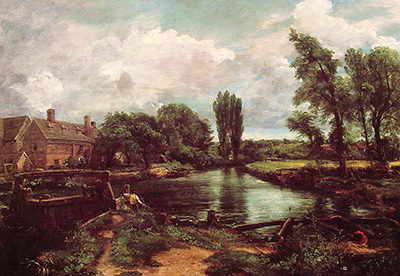Flatford Mill from a Lock on the Stour is one of several sketches made by John Constable early in his career, around 1811, and was probably a preparation for his 1812 painting, Flatford Mill From the Lock. The artist's father owned both this site and Dedham Mill, with the River Stour being used to transport coal and corn.
Constable produced many oil sketches in the vicinity during his lifetime, and retained a great affection for the countryside of his childhood, around East Bergholt on the Suffolk/Essex border. John Constable often used a technique known as impasto, in which brushes or palette knives were thickly covered with oil paint and transferred to the final surface, in this case paper laid on canvas. Brush strokes were often visible, and here, they convey movement to a scene worked rapidly in the open air, capturing the changeable weather conditions. There is still, however, plenty of detail, with light playing on water and distant haymakers, so that while nature dominates, human toil is still apparent.
It's possible to see the influence here of Claude Lorrain and his two Seaport works, which Constable admired. In addition, an interest in Rubens, and the Dutch painter Jacob van Ruisdael, helped Constable to develop his own sense of colour and composition, traits that were better appreciated in France than in England during his lifetime. In turn, he inspired the Barbizon School and the French Romantics, with Delacroix re-working the background of one of his paintings after seeing some of Constable's canvases. Constable preferred to work outdoors when possible, and although French impressionists like Pissarro and Monet played down the idea of a connection with either Constable or Turner, the former certainly influenced British impressionists such as Philip Steer. Later artists whose work shows an admiration for the Suffolk painter include Freud, Kossoff and arguably, George Shaw.
The art critic John Ruskin disliked Constable's scenes, and his view of nature was at odds with the way it was portrayed by the Pre-Raphaelites, taking his style out of favour for a while. Today, of course, John Constable is appreciated worldwide, and Flatford Mill from a Lock on the Stour, now at the Royal Academy, is an early example of the techniques and interpretations that would come to be acknowledged for their vision. In his lifetime, in any case, he declared that he preferred to remain poor in England, rather than to be rich abroad - after all, it was English landscapes that inspired his masterpieces.




